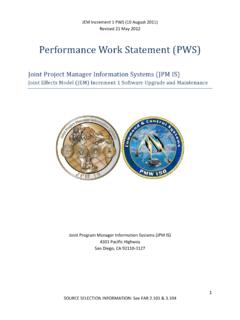Transcription of A Systematic Approach to Performance Evaluation …
1 A Systematic Approach to Performance Evaluation A Systematic Approach to Performance Evaluation Performance Evaluation is the process of determining how well an existing or future computer system meets a set of alternative Performance objectives. Arbitrarily selecting Performance metrics, Evaluation techniques, and workloads often leads to inaccurate conclusions. How should one carry out a Performance Evaluation study? The answer is to follow a Systematic Approach . The methodology proposed here involves six steps: Understand the current environment and define goals for analysis. Identify and gather relevant Performance metrics. Select the appropriate Evaluation technique. Define characteristic workloads.
2 Analyze and interpret the data. Present the results. The purpose of this article is to provide the Performance analyst with a Systematic Approach to Performance Evaluation and point out some common mistakes that can be avoided. Step One - Define Your Goals There is no such thing as an all-purpose system Performance model. Each model must be developed with an understanding of the system and the problem to be solved. Therefore, the first step in conducting a Performance Evaluation study is to clearly state the goals of the project and obtain a global definition of the current environment based on these goals. Setting goals involves deliberate interaction with system users and decision- makers, taking care to avoid any preconceived biases or beliefs.
3 Embarking on a Performance study to prove that one alternative is better than another is bound to be met with skepticism. It is best to base all conclusions and recommendations on the results of the model rather than on what one party wants to hear. The definition of the computing environment may vary depending upon the goals of the study. The system definition may consist of the CPU, memory or I/O subsystem, the network, the database, or the entire computing system itself. How the environment is defined affects the choice of Performance metrics and workloads needed to compare alternative objectives. At a minimum, the overall description should include the following system components: hardware configuration, operating system, support software, and major applications.
4 In addition, a list of services provided by these components and an understanding of existing service level agreements, user profiles, administrative controls, peak time windows and possible alternatives and problems should be part of the preliminary examination the system environment. A large share of the analysis effort of a Performance problem goes into defining the problem and stating the goals. Putting a lot of effort into this initial step helps to narrow the scope of the study and reduces the time and cost required to find the solution. Analysis without understanding the problem or goals of the study will only result in inaccurate conclusions. A Systematic Approach to Performance Evaluation Step Two - Choosing Performance Metrics Once the goals of the Performance study have been defined and you have a clear understanding of the system or systems to be evaluated, you can move on to identifying and gathering relevant Performance metrics.
5 The choice of metrics may depend on the tools available to you for collecting and measuring system data, and vice versa. An understanding of the type of data available through accounting logs, hardware and software monitors, load generators, program analyzers, and other measurement tools is helpful in this step. Then, depending on the objectives of the study, data collection should take place during a typical (if averages are being studied) or peak (if system capacity is of concern) time period. It is also important to consider the constraints and limitations imposed by the alternatives being studied and the time available for the decision when choosing your metrics. Most importantly, your choice of Performance metrics should depend upon the goals of the study.
6 A common mistake is to choose those metrics that can be easily computed or measured rather than those that are relevant to your objectives. Examples of commonly used Performance metrics are throughput and response time. But, care must be taken when using even these standard metrics. For example, if the objective of your study is to compare the expected throughput of two alternative systems, you may run into complications during the analysis phase of your Evaluation comparing the MIPS measured on one system to the VUPS reported by another. Furthermore, understanding exactly how a metric, such as response time, is measured and reported plays a role in building your Performance model. Ignoring important parameters, choosing inappropriate metrics, or overlooking differences in metrics from one system to another may render your results useless.
7 A good way to start identifying relevant Performance metrics is to make a list of all the system and workload metrics that affect the Performance of the system(s) under consideration. In general, the metrics will be related to the speed, accuracy, and availability of system services. System parameters include both hardware and software parameters and may include such measurements as working set size or CPU clock speed. The global definition of the computing environment created in step one should be of help in defining the system parameters. Workload parameters are characteristics of users' requests such as traffic intensity, system load, and resource consumption. Pay special attention to those workload parameters that will be affected by your alternative Performance objectives as well as those that have a significant impact on Performance CPU utilization, total I/O.
8 Operations, memory usage, page faults, and elapsed time. As a final note, it is important to understand the randomness of the system and workload parameters that affect the Performance of your system. Some of the metrics you've identified and gathered in this step will be varied during the Evaluation while others will not. Observing system behavior for several days or weeks will allow you to determine realistic values and distributions for each metric included in the analysis. The ability to accurately reflect system behavior in your model through the use of relevant metrics will lead to much tighter conclusions. Step Three - Selecting the Appropriate Evaluation Technique Performance management is the process of ensuring that a computer system meets predefined Performance objectives consistently and efficiently, both now and in the future.
9 In order to evaluate future system behavior, the analyst must use predictive models. There are four modeling techniques commonly used for Performance management: linear projection; analytic modeling; simulation; and benchmarking. Each method has its own merits and drawbacks and, in some cases, choosing one technique over another may be a simple matter of economics. Knowing what data, tools, and skills are available, what level of accuracy or detail is required, how much time and money is devoted to the project, and whether the alternatives to be evaluated exist or have yet to be developed all play a key role in determining which technique should, or can, be used. Linear projection involves collecting past data, extending or implying trends through the use of scatter plots and regression lines, and comparing the trend line with the current capacity of the system.
10 Although linear projection Page 2 of 5. A Systematic Approach to Performance Evaluation is used quite frequently to make assumptions about future behavior, the Performance of computer systems is far from linear. Therefore, any linear relationship determined between two system components should only be used to understand the current (or past) behavior. Linear projection is best used when you want a first approximation to a very simple model. Analytic modeling uses queuing theory formulas and algorithms to predict response times and utilization projections from workload characterization data and key system relationships. Basically, analytic models require input data such as arrival rates, user profiles, and service demands placed by each workload on various system resources.





